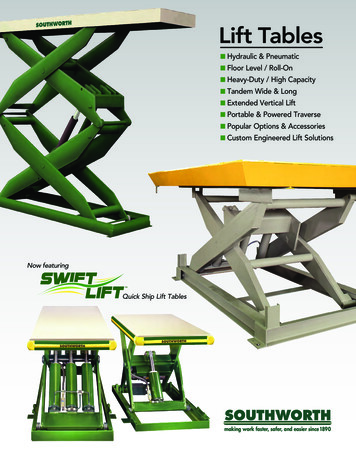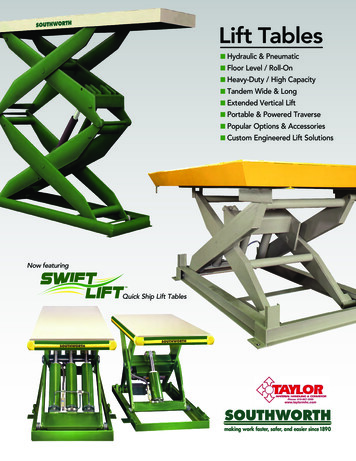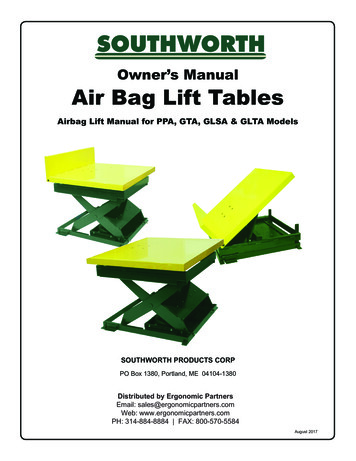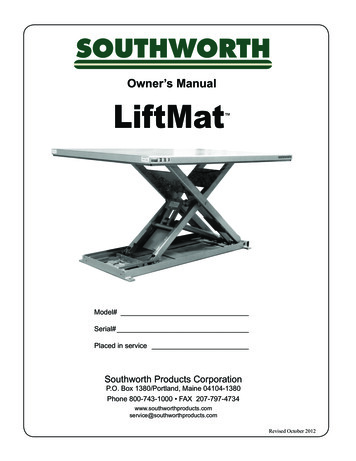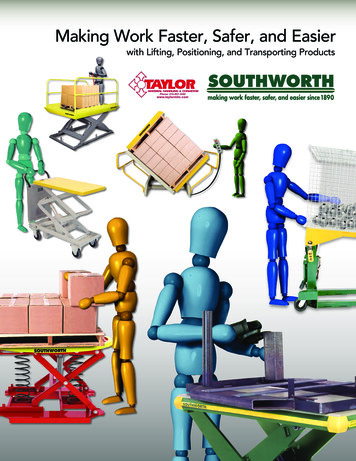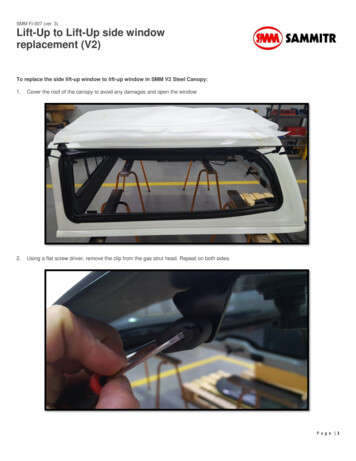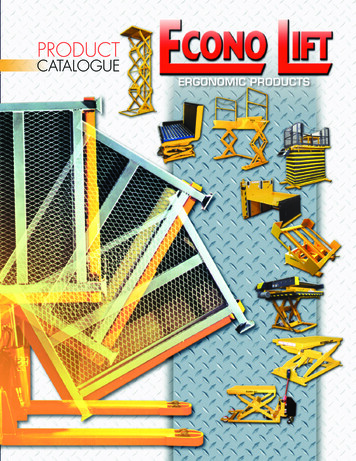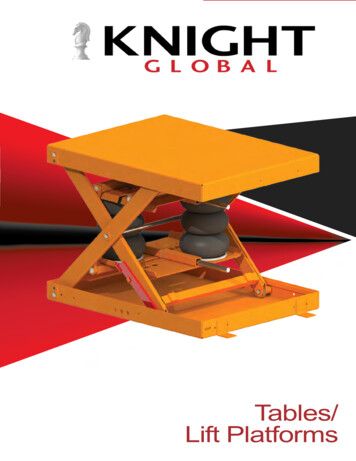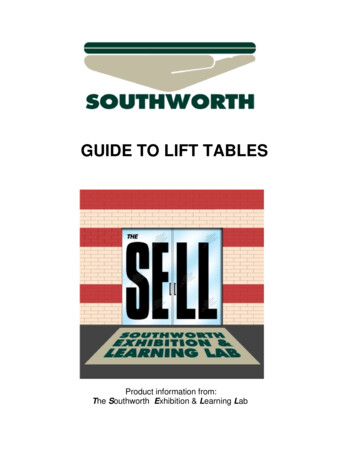
Transcription
GUIDE TO LIFT TABLESProduct information from:The Southworth Exhibition & Learning Lab
Lift Table BasicsTHE TOP OR PLATFORMWhat is a Lift Table?A lift table is exactly what its name implies.In its simplest form, it is a platform or tablethat can be raised or lowered to any heightdesired within its range of vertical movement.The basic parts of a lift table are:THE BASEThe base supports the rest of the assembly. Ithas to be strong, rigid, and stable. In mostcases it is designed to be lagged to the floor butit can also be built into a pit or supplied withwheels or casters or furnished in a semi-liveportable configuration with a skid spotter.The platform can be of any size that iscompatible with the base and legs. Specifically,the platform can be no smaller than the length orwidth of legs/base. Platforms can be larger thanthe legs/base. Platforms can be furnished with avariety of options such as conveyor tops,turntables, tilt tops, or tops equipped withclamps or special work fixtures.TANDEM LIFTSWhen unusually long orheavy loads are involved, lifttables can be furnished ineither end-to-end or side-toside tandem versions.THE LEG ASSEMBLIESThe leg assemblies provide true and levelvertical motion while supporting the platform ortop. The two sets of legs are connected byshafts at the center pivot points and upper andlower hinged ends.At the other end, rollers attached to thelegs move back and forth on the base frame andthe underside of the platform.MULTIPLESCISSOR LIFTSFor extra high lifting with smallfootprint, multiple scissor lifttables are ideal.1
THE POWER PACKAGEThe power package (most commonly electrohydraulic) consists of an electric motor, a hydraulicpump, a hydraulic fluid reservoir, hydraulic cylinder,piping, valving, and controls.When the UP control is activated, the pumppumps fluid from the reservoir into the cylinderscausing the piston and shaft to move. The pistonshaft is mechanically linked to the leg assembliesand drives them to raise the platform. A check valvein the hydraulic line between the pump and thecylinder prevent fluid from flowing backwards so theplatform will remain at whatever height it is at whenthe UP control is activated.When the DOWN control is activated, a solenoiddown valve opens, allowing hydraulic fluid to flowback to the reservoir. The motor does not run whenthe lift is lowering.The weight of the platform and gravity combine tocreate pressure in the cylinder which forces the fluidto flow back to the reservoir. A flow control valvelocated in the line between the down valve and thereservoir can be adjusted to provide the mostdesirable down speed.When the DOWN control is deactivated, the downvalve closes and the table remains at the height it isat when the control is activated. The valvearrangement prevents the table from lowering ifthere is a power failure.WORKPLACE SAFETYHOW TO SPOT SELL OPPORTUNITIES1.WORKPIECE FEEDING/OFFLOADINGThe feeding and offloading of machines is a processwhich requires continual lifting and positioning ofworkpieces. Theseactivities often developproduction-robbingfatigue and even moreserious cumulativetrauma disorders.Fatigue can also resultin damage to workpieces or equipment.By using lift tables, lifttransporters or palletizing devices to accomplishlevel (no lifting) feeding and offloading, many ofthese injuries and costly downtime can be avoided.2. LOADING AND UNLOADING PALLETSThe bending, lifting and reaching required is not onlystrenuous and fatiguing, it can also result in backinjuries.The use of springactuated PalletPal LevelLoaders, whichautomatically adjust inheight as theload is progressivelyadded or removed,allows the operator toload with little or nolifting. Level Loadersalso allow the operator to rotate the pallet for nearside loading and unloading.THE CONTROL3. WORKING OUT OF PARTS BASKETSThe standard control can be either pushbutton orfoot switch. Where machines operate on other than115 volt power, a motor starter and transformer isfurnished to convert the power to single-phasecontrol power needed for operation of thepushbuttons or foot switch. Machines that operateon 115 volt single-phase power do not require atransformer.Bending, reaching, stretchingand lifting can be seriousproblems when removingparts from baskets. Sincethis is usually a repetitiveprocess, the danger of injuryincreases with time. Byusing lifting and tiltingequipment, baskets can bepositioned so that the worker can remove the partsfrom the top to the bottom of the basket with thesame minimum effort.2
4. MULTILEVEL ASSEMBLING7. ACCESSING HIGH WORKMany light assembly activities such as those in theelectronics industry require workers to bend, stoop,squat and stretch in order to reach various levelsand sides of assembliesIt is hazardous to have people up on ladders orclimbing up or down from scaffolding or fixed heightplatforms in order to weld, paint or work on largeassemblies or to access materials in carousels. Thedanger of the worker falling or dropping a tool onanother worker isalways present.Powered personnel liftstake the worker, thetools and any partsrequired to thenecessary height, bothsafely and efficiently.Continuous activities of this type can lead to fatigue,decreased productivity and possible injury. Insteadof working from a variety of uncomfortable andinefficient positions, workers should use poweredmechanical lifting equipment to raise and lower thework piece to more comfortable and productiveworking positions. In many cases, the addition of aturntable allows the worker to have access to allsides of the work without walking.5. TRANSPORTINGWhenever flatbed trucks or dollies are used, workersare frequently required to liftmaterial or equipment fromthe truck to a bench ormachine. In such cases, thedanger of lifting relatedinjuries can be greatlyreduced by using liftertransporters, which combinethe functions of both a wheeled transporter and a lifttable.6. FEEDING AND OFFLOADING LARGEPIECESThis is a job that requires two people and involvesbending, reaching and stretching. By continuallymaintaining sheets ata level height, lifttables simplify thefeeding and offloadingprocess and allow thejob to be handled byone person without thedanger of liftinginjuries.8. HANDLING LONG WORKPIECESLong workpieces are aprime source ofaccidents in theworkplace. Themanipulation of even alight workpiece isawkward and a threatto the handler andanyone else is the vicinity. Long workpiecesproduce a variety of handling problems in transfer,positioning and storage, making them excellentcandidates for mechanical handling equipment. Theuse of tandem lift tables allows even the longestworkpiece to be lifted and handled with ease andsafety.BENEFITS OF LIFT TABLESThroughout industry there is a continuing need to liftand position workpieces and materials. If workersare asked to accomplish this lifting and positioningwithout the aid of powered mechanical equipment,the results can vary from fatigue and low productivityto serious personnel accidents. Between these twoextremes are injuries that relate to continuous,repetitive lifting and awkward positioning such asback pain and carpal tunnel syndrome.Lift tables are the ideal solution to lifting andpositioning problems for the following reasons:3
1. STABLE PLATFORM4. PROGRAMMABLE MOVEMENTUnlike hoists, cranes, or manipulators, lift tablesprovide a stable platform for lifting and loweringmaterials. The chance of accidentally dropping aworkpiece is much lower, and the danger of asuspended load swinging and causing injury toworkers is eliminated.Movement can be programmed, and tables can beintegrated into special handling systems.2. INFINITE HEIGHT ADJUSTMENTA lift table is designed to smoothly move up or downto any desired height and to maintain that heighteven if there is a power failure.3. VERSATILITYLift tables can be provided with a wide range ofoptions such as conveyor tops, tilting tops, and topswith special fixturing such as clamps and automaticwork positioning devices.5. PORTABILITYLift tables can be provided in portable configurationsusing wheels or casters and in semiportableconfigurations using wheels on one end with a skidspotter.6. WIDE VERTICAL RANGELift tables can be installed in pits for absolute zerolowered height or in floor height, floor mountedversions, or provided with multiple scissor legs forhigh lifting.7. LOW MAINTENANCELift tables are rugged, heavy-duty machinesdesigned to provide years of reliable service withminimum maintenance.Advantages of Southworth Lift TablesCONTOURED LEGSHEAVY-GAUGE STEEL:With extra width at the pivot point, Southworth’scontoured legs combine great strength with lowercollapsed height.All Southworth lift tables are built for ruggedindustrial service with heavy structural steelcomponents and submerged-arc weldments.LUBRICATED-FOR-LIFE BEARINGSCONSERVATIVELY RATEDAll pivot points have hardened pins that operate inlubricated-for-life, virtually maintenance-freebushings.Southworth lift tables are conservatively rated basedon ANSI Standards.HEAVY-DUTY TORQUE TUBESLOW-PRESSURE HYDRAULICSLow operating pressure extends the life of cylindersand other components.Torque tubes minimize twisting and deflection forhigh degree of rigidity and stability.HEAVY-DUTY HOSES AND FITTINGSHUMAN-ENGINEERED CONTROLSAll controls are grouped for ease of operation and toallow fast precise positioning at any height.SOUTHWORTH DEVELOPEDCYLINDERSHard chrome-plated piston rods are rust andcorrosion resistant, and cylinder walls are honed forimproved seal life and performance.All Southworth lifts have heavy-duty hoses with burststrength 350% greater than the hydraulic operatingpressure.ADJUSTABLE FLOW CONTROLAdjustable, pressure compensated flow control valvewith lock out.4
TELL-TALE VACUUM LINE HYDRAULICSCOMFORT EDGEClear plastic return line from rod bearing to tankgives visual indication of need to repack cylinder andprevents fluid spillage in the event of a bypass.A rounded, user friendly plastic table edge foroperator comfort.ROLL RETAINERSTHE INDUSTRY’S BEST WARRANTYRollers are captured in the base by means ofretainers to prevent accidental separation ormisalignment. All oversized tabletops also includean upper set of retainers.Simple all-inclusive one year parts and laborwarranty with no component exclusions orexceptionsHow to Specify a Lift Table5
GUIDE TO SOUTHWORTHINQUIRY SHEETPROVIDINGINQUIRYAPPLICATIONINFORMATION .Southworth products are applied toanextremelybroadvarietyofHow is Lift Used? What are the steps ofthe operation? Load? Unload?Product Being Handled? What is it?industrial applications. In most sales,Cartons? Large parts? etc.it is necessary to customize theSize & Weight of Load. What are themachine to make it suitable for thedimensions and actual maximum weight ofproduct being handled?environment in which it will beplaced.It may also need to bemodifiedtomeetperformancedemands. Accessories that should beadded and/or options that should bepresented to you and your customercanonlybeunderstandconsideredtheweplatform desired?Travel Time Up/Down. Does thecustomer have a specific amount of timethat the table needs to raise/lower in?Lowered Height. When the lift is fullylowered, does the platform need to be aspecific distance off the floor?applicationVertical Travel. Not to be confused withparameters. The information on theraised height. Vertical travel is the distancethat a lift can travel from its fully loweredheight.inquiryallifPlatform Size. Is there a specific sizesheetprovidesthatinformation to us.Raised Height. Distance from theYour very best insurance that you willplatform to the floor with the lift fully raised.For surface mounted lifts, lowered height vertical travel raised height.For pit mounted lifts, vertical travel is theraised height.be quoting the right equipment andthe least expensive equipment isforyoutoprovideinformation as possible.asmuchHow is Lift Loaded? By fork truck? Byhand? Conveyor? Over the side or end?When raised or lowered?6
Jogs. Not to be confused with cycles. ATurntable. Rotating top mounted onto (orjog is the number of incremental stops thatthe machine makes during one completecycle.into) the lift platform. Lift table capacity isderated accordingly. Available in manual orpowered.Cycles. One full up and down movement.Tilt Top. Use Tilt Table ApplicationHigh usage (over 50,000 yearly) mayrequire special componentry (see Tech SheetWorksheet.S-2).Other Options. Conveyor, vee cradle,BASEPortable. Moving loaded? Movingempty? Semi-live? Casters? Trackmounted? Powered horizontal floor travel?Bellows Accordion Skirting. Skirting isattached to underside of the platform andencloses base and leg assembly. Requiresoversized platform. Note: Perimeter skirtingis special.PLATFORMDiamond Tread. Provides increasedspecial fixtures, etc. mounted to liftplatform. Will require derating the capacity.POWER UNIT AND CONTROLSPower Unit. Can be internal or external.If lift table is pit mounted, externalpower unit is standard and stronglyrecommended.Motor Starter/Transformer. Requiredwhen machine is to operate at 3 phaseprimary power. Transformer reducesprimary voltage to secondary voltage (115Vor 24V) for controls.Limitswitches. Upper – To restricttraction for personnel or product onplatform.upward vertical travel. Lower – For signalonly; not to be used to limit downwardtravel.Handrails. 42” high. Required by ANSINEMA Rating (see Tech Sheet CS-2).Standard when platform rises 48” ormore off the floor and personnel will be onlift.NEMA 1 – General PurposeNEMA 4 – Wet or moist environmentNEMA 7 or 9 – Explosion proofNEMA 12 – Dusty EnvironmentNEMA 13 - Oiltight.7
MOST SUCCESSFUL SIC CODES FORSOUTHWORTH EQUIPMENTSIC CodeDescriptionRank35Industrial Machinery & ated Metals820Food & Kindred Products725Furniture & Fixtures528Chemicals & Allied Products526Paper & Allied Products530Rubber533Manufacturing Primary Metals524Lumber & Wood Products427Printing & Publishing432Stone & Clay4Rank is set to the scale of 1-10 with 10 being the bestSouthworth Products Corp.P.O. Box 1380Portland, ME 04104-1380Tel: 800-743-1000 Fax: 207-797-4734www.SouthworthProducts.come-mail: salesinfo@SouthworthProducts.comCopyright October, 1999
Lift Table Basics THE TOP OR PLATFORM What is a Lift Table? A lift table is exactly what its name implies. In its simplest form, it is a platform or table that can be raised or lowered to any height desired within its range of vertical movement. The basic parts of a lift table are: THE BASE The base supports the rest of the assembly. It
